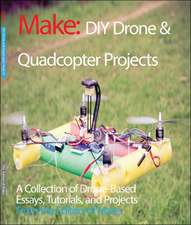Efficient Dynamic Simulation of Robotic Mechanisms: The Springer International Series in Engineering and Computer Science, cartea 203
Autor Kathryn Lillyen Limba Engleză Hardback – 30 noi 1992
In conjunction with the dynamic simulation algorithms, efficient algorithms are also derived for the computation of the joint space and operational space inertia matrices of a manipulator. The manipulator inertia matrix is a significant component of any robot dynamics formulation and plays an important role in both simulation and control. The efficient computation of the inertia matrix is highly desirable for real-time implementation of robot dynamics algorithms. Several alternate formulations are provided for each inertia matrix.
Computational efficiency in the algorithm is achieved by several means, including the development of recursive formulations and the use of efficient spatial transformations and mathematics. All algorithms are derived and presented in a convenient tabular format using a modified form of spatial notation, a six-dimensional vector notation which greatly simplifies the presentation and analysis of multibody dynamics. Basic definitions and fundamental principles required to use and understand this notation are provided. The implementation of the efficient spatial transformations is also discussed in some detail.As a means of evaluating efficiency, the number of scalar operations (multiplications and additions) required for each algorithm is tabulated after its derivation. Specification of the computational complexity of each algorithm in this manner makes comparison with other algorithms both easy and convenient.
The algorithms presented in Efficient Dynamic Simulation of Robotic Mechanisms are among the most efficient robot dynamics algorithms available at this time. In addition to computational efficiency, special emphasis is also placed on retaining as much physical insight as possible during algorithm derivation. The algorithms are easy to follow and understand, whether the reader is a robotics novice or a seasoned specialist.
| Toate formatele și edițiile | Preț | Express |
|---|---|---|
| Paperback (1) | 633.35 lei 6-8 săpt. | |
| Springer Us – 27 sep 2012 | 633.35 lei 6-8 săpt. | |
| Hardback (1) | 640.06 lei 6-8 săpt. | |
| Springer Us – 30 noi 1992 | 640.06 lei 6-8 săpt. |
Din seria The Springer International Series in Engineering and Computer Science
- 24%
 Preț: 1041.98 lei
Preț: 1041.98 lei - 20%
 Preț: 643.50 lei
Preț: 643.50 lei - 18%
 Preț: 1225.62 lei
Preț: 1225.62 lei - 18%
 Preț: 965.02 lei
Preț: 965.02 lei - 20%
 Preț: 646.12 lei
Preț: 646.12 lei - 18%
 Preț: 948.79 lei
Preț: 948.79 lei - 20%
 Preț: 646.62 lei
Preț: 646.62 lei - 15%
 Preț: 637.46 lei
Preț: 637.46 lei - 20%
 Preț: 643.83 lei
Preț: 643.83 lei - 18%
 Preț: 949.23 lei
Preț: 949.23 lei - 20%
 Preț: 644.48 lei
Preț: 644.48 lei - 20%
 Preț: 994.92 lei
Preț: 994.92 lei - 20%
 Preț: 645.97 lei
Preț: 645.97 lei - 18%
 Preț: 946.87 lei
Preț: 946.87 lei - 20%
 Preț: 995.57 lei
Preț: 995.57 lei - 18%
 Preț: 956.99 lei
Preț: 956.99 lei - 20%
 Preț: 644.98 lei
Preț: 644.98 lei - 15%
 Preț: 649.54 lei
Preț: 649.54 lei - 18%
 Preț: 950.21 lei
Preț: 950.21 lei - 18%
 Preț: 1221.38 lei
Preț: 1221.38 lei - 18%
 Preț: 957.62 lei
Preț: 957.62 lei - 15%
 Preț: 643.99 lei
Preț: 643.99 lei - 18%
 Preț: 948.47 lei
Preț: 948.47 lei - 18%
 Preț: 947.35 lei
Preț: 947.35 lei - 20%
 Preț: 1284.65 lei
Preț: 1284.65 lei - 20%
 Preț: 1628.31 lei
Preț: 1628.31 lei - 20%
 Preț: 1285.78 lei
Preț: 1285.78 lei
Preț: 640.06 lei
Preț vechi: 753.01 lei
-15% Nou
Puncte Express: 960
Preț estimativ în valută:
122.48€ • 130.97$ • 102.12£
122.48€ • 130.97$ • 102.12£
Carte tipărită la comandă
Livrare economică 18 aprilie-02 mai
Preluare comenzi: 021 569.72.76
Specificații
ISBN-13: 9780792392866
ISBN-10: 0792392868
Pagini: 136
Ilustrații: XI, 136 p.
Dimensiuni: 155 x 235 x 11 mm
Greutate: 0.41 kg
Ediția:1993
Editura: Springer Us
Colecția Springer
Seria The Springer International Series in Engineering and Computer Science
Locul publicării:New York, NY, United States
ISBN-10: 0792392868
Pagini: 136
Ilustrații: XI, 136 p.
Dimensiuni: 155 x 235 x 11 mm
Greutate: 0.41 kg
Ediția:1993
Editura: Springer Us
Colecția Springer
Seria The Springer International Series in Engineering and Computer Science
Locul publicării:New York, NY, United States
Public țintă
ResearchCuprins
1 Introduction.- 1.1 Scope and Contents.- 1.2 The Dynamic Simulation Problem.- 1.3 Direct Dynamics for Robotic Systems.- 1.4 Dynamics of Simple Closed-Chain Mechanisms.- 1.5 Organization and Reader’s Guide.- 2 System Modelling and Notation.- 2.1 Introduction.- 2.2 Kinematic and Dynamic Parameters of a Robotic Mechanism.- 2.3 General Joint Model.- 2.4 Summary.- 3 Alternate Formulations for the Joint Space Inertia Matrix.- 3.1 Introduction.- 3.2 Previous Work.- 3.3 Additional Notation and Background.- 3.4 The Algorithms.- 3.5 Efficient Transformation of Spatial Quantities.- 3.6 Computational Requirements.- 3.7 Summary and Conclusions.- 4 Alternate Formulations for the Operational Space Inertia Matrix.- 4.1 Introduction.- 4.2 Previous Work.- 4.3 The Operational Space Formulation.- 4.4 The Operational Space Inertia Matrix.- 4.5 The Algorithms.- 4.6 Computational Requirements.- 4.7 Summary and Conclusions.- 5 Efficient Dynamic Simulation of A Single Closed Chain.- 5.1 Introduction.- 5.2 Previous Work.- 5.3 Equations of Motion and Joint Accelerations.- 5.4 Acceleration of the End Effector.- 5.5 Tip Constraints.- 5.6 Dynamic Simulation Algorithm for a Single Closed Chain.- 5.7 Computational Requirements.- 5.8 Summary and Conclusions.- 6 Efficient Dynamic Simulation of Simple Closed-Chain Mechanisms.- 6.1 Introduction.- 6.2 Previous Work.- 6.3 System Configuration and Problem Statement.- 6.4 System Dynamic Equations.- 6.5 Dynamic Simulation Algorithm for Simple Closed-Chain Mechanisms.- 6.6 An Alternate Form of the Simulation Algorithm.- 6.7 Computational Requirements.- 6.8 Summary and Conclusions.- 6.9 A Final Note.
Recenzii
` The case for recommending this book is that it represents a state of development in the formulation of efficient algorithms and that it holds a record that specialists can argue over and try to beat. '
Proceedings of the Institution of Mechanical Engineers, 208
Proceedings of the Institution of Mechanical Engineers, 208











